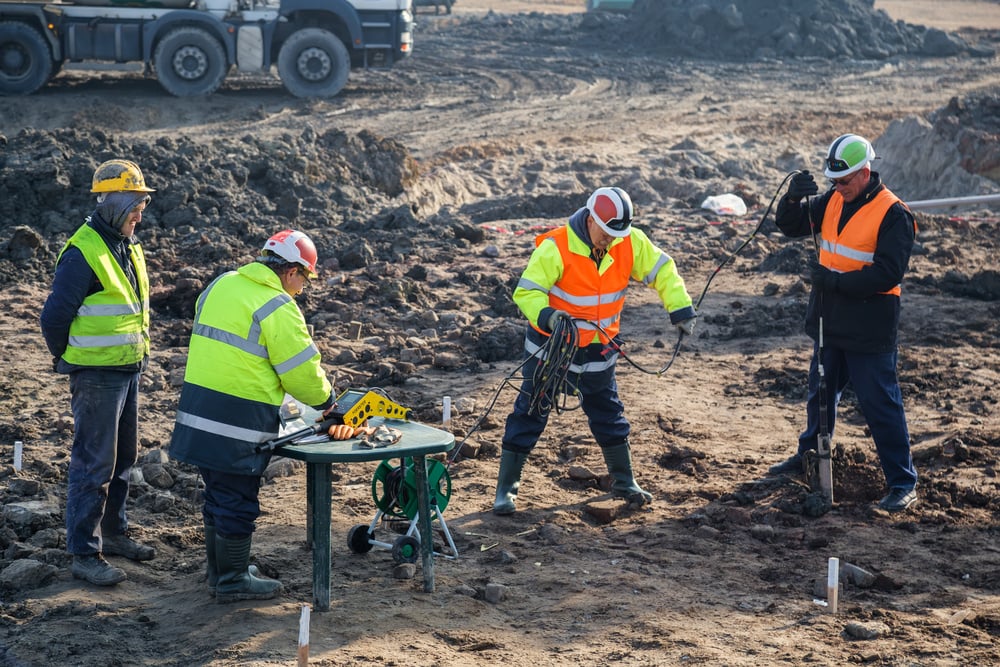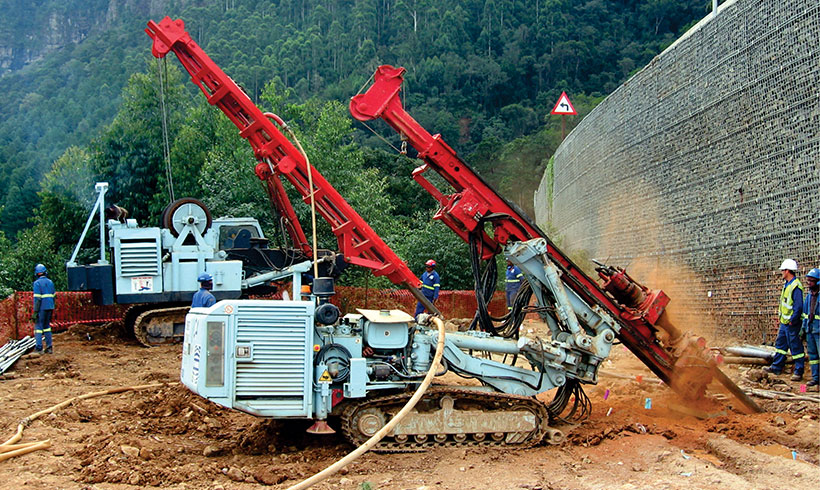The Geotechnical Engineering For Construction Projects PDFs
The Geotechnical Engineering For Construction Projects PDFs
Blog Article
The Best Guide To Geotechnical Engineering For Construction Projects
Table of ContentsRumored Buzz on Geotechnical Engineering For Construction ProjectsGeotechnical Engineering For Construction Projects - The FactsNot known Incorrect Statements About Geotechnical Engineering For Construction Projects A Biased View of Geotechnical Engineering For Construction ProjectsHow Geotechnical Engineering For Construction Projects can Save You Time, Stress, and Money.Some Of Geotechnical Engineering For Construction ProjectsIndicators on Geotechnical Engineering For Construction Projects You Need To Know
and Kovacs, W. (1981 ), An Introduction to Geotechnical Design, Prentice-Hall, Inc. Deep Scan Tech (2023 ): Deep Scan Tech uncovers concealed structures at the site of Denmark's highest building. "Geofrost Coring". GEOFROST. Fetched 20 November 2020. Han, Jie (2015 ). Concepts and Technique of Ground Renovation. Wiley. ISBN 9781118421307. RAJU, V. R.Ground Renovation Technologies and Situation Histories. Singapore: Research Study Publishing Solutions. p. 809. ISBN978-981-08-3124-0. Ground Renovation Concepts And Applications In Asia. Pariseau, William G. (2011 ). Design analysis in rock technicians. CRC Press. Hegde, A.M. and Palsule P (Geotechnical Engineering for Construction Projects).S. (2020 ), Performance of Geosynthetics Reinforced Subgrade Subjected to Repetitive Vehicle Plenties: Experimental and Numerical Studies.
Cengage Knowing, Stamford, 666 p. Atkinson, J., 2007. The auto mechanics of soils and foundations. Taylor & Francis, N.Y., 442 p. Drifting Offshore Wind Generators: Responses in a Sea state Pareto Ideal Styles and Financial Analysis, P. Sclavounos et al., October 2007. Nicholson, D, Tse, C and Penny, C. (1999 ). The Observational Method in ground design principles and applications.
How Geotechnical Engineering For Construction Projects can Save You Time, Stress, and Money.
Lab and field testing plays an important function in this procedure. By extracting samples from the planet's subsurface and applying a collection of tests, geotechnical engineers can forecast the behaviour of dirt layers and review their viability for different construction efforts. The significance of geotechnical engineering in civil design can not be overstated, attributable to a number of factors: The first action in any kind of geotechnical research entails figuring out the soil type at the building and construction site.
Understanding these attributes ensures that only ideal dirt kinds are chosen for the advancement, therefore averting prospective architectural failings. The structure works as the bedrock of any type of building and construction task. Picking the appropriate foundation type is a decision that depends upon the thorough analysis offered by geotechnical design. This makes certain the long life and security of frameworks by accommodating the loads they will bear.
Geotechnical site investigation is a critical action in the preparation and execution of any type of building project. It involves the collection and analysis of information connected to the physical residential properties of dirt and rock under a recommended building site. This information is essential for the design and building and construction of risk-free, steady, and sustainable frameworks.
The 8-Second Trick For Geotechnical Engineering For Construction Projects
In this blog, we will certainly explore the relevance of geotechnical website investigation, its different components, and exactly how it profits building and construction tasks. Geotechnical site examination, additionally called subsurface exploration, includes a collection of activities focused on establishing the soil, rock, and groundwater problems at a construction website. The key objectives are to recognize potential geotechnical hazards, analyze the engineering residential or commercial properties of subsurface materials, and supply referrals for the design and building of structures, preserving walls, and various other frameworks.
This might include geological maps, aerial photos, previous investigation reports, and historical data. The desk study helps in determining prospective geotechnical problems and preparing the succeeding fieldwork. Complying with the desk research study, a site reconnaissance is conducted to visually inspect the website and its environments. This includes observing the topography, drainage patterns, existing structures, plant life, and any type of indicators of instability or erosion.
Some Known Incorrect Statements About Geotechnical Engineering For Construction Projects
Shallow examination pits are dug deep into to straight observe and sample the dirt and rock. This approach works for studying the top layers of the subsurface and identifying near-surface risks. Non-invasive geophysical approaches, such as seismic refraction, ground-penetrating radar (GPR), and electrical resistivity tomography (ERT), are utilized to map subsurface problems and identify anomalies.
Soil and rock samples gathered throughout the field investigation are subjected to laboratory testing to identify their physical and mechanical buildings. These examinations give essential data for geotechnical analysis and layout.
The primary advantage of geotechnical website examination is ensuring the safety and security and security of frameworks. By understanding the subsurface conditions, engineers can make foundations and other structural components that can withstand the lots and ecological pressures they will certainly undergo. This lessens the danger of negotiation, subsidence, and structural failure.
Unknown Facts About Geotechnical Engineering For Construction Projects
For instance, recognizing soil qualities can lead the choice of excavation strategies, dewatering methods, and ground enhancement steps. This ensures reliable and secure construction techniques. Geotechnical site examinations are frequently required by constructing codes and policies. Adhering to these demands guarantees compliance with legal and safety criteria, avoiding possible legal liabilities and task delays.
This check my reference info is indispensable for project supervisors, architects, and specialists in establishing practical schedules, budget plans, and contingency plans. Geotechnical Engineering for Construction Projects. Skyscraper Building in a Coastal AreaIn a coastal city, a high-rise domestic building was intended on a site with suspected loosened sand down payments and a high water table. A comprehensive geotechnical examination, including borehole exploration, CPT, and geophysical studies, was conducted
Things about Geotechnical Engineering For Construction Projects
Based upon these findings, the foundation design was customized to consist of deep pile structures extending right into stable strata, and ground enhancement methods, such as vibro-compaction, were executed to alleviate liquefaction risks. This proactive approach guaranteed the safety and security of the structure while staying clear of costly post-construction remediation. Infrastructure Growth on a Sloping TerrainA significant framework project, including the building of a highway and bridges, was intended on an uneven surface with high slopes.

The Leaning Tower of Pisa (Italy), a famous building marvel, is well known for its unintended tilt from considerable geotechnical issues. The tower's foundation was inadequately developed to manage the soft, unsteady have a peek at these guys dirt beneath it, bring about unequal negotiation and its unique lean. Our globe is dotted with outstanding facilities projectsfrom towering high-rise buildings to sprawling bridgesall standing testimony to the advancement of the different construction tools and approaches readily available.
Geotechnical engineering is a customized area within civil engineering that concentrates on examining explanation the habits of earth materials. This branch dives deep into the groundinvestigating just how the dirt, rock, and groundwater at a construction site can influenceand be affected bythe framework that we set up on and into them. Before a single brick is laid or a concrete foundation poured, geotechnical engineers probe into the earthgathering crucial data regarding the website's soil composition, rock framework, and groundwater degrees.
Geotechnical Engineering For Construction Projects - Truths

is a tool made use of to examine the honesty and load-bearing ability of heaps throughout setup, leveraging the principle of wave proliferation. It optimizes building performance by giving real-time analyses, therefore making certain risk-free and effective heap structures. Among the sensible applications of geotechnical engineering includes making a decision and carrying out the best methods for structure construction.
Stack driving represents even more than the simple act of putting structural components right into the ground. On the contrary, it is a meticulously managed procedure of transferring a structure's tons past the less steady soil layers more detailed to the surfacedown to the more considerable strata that exist under. In the situation of stack driving, take into consideration exactly how geotechnical engineers skillfully use this method to uniformly distribute the structure's weight.
Report this page